Organizational Behaviour Report: A M Limited Case Study Analysis
VerifiedAdded on 2020/10/05
|16
|4540
|405
Report
AI Summary
This report provides a comprehensive analysis of organizational behavior, using A M Limited as a case study. It explores the influence of organizational culture, power dynamics, and politics on team activity and business goals. The report delves into the impact of different cultural models (power, role, task, and person culture), various types of power (referent, legitimate, reward, coercive, and expert), and the negative effects of workplace politics. Furthermore, the report examines motivation theories, including Maslow's Hierarchy of Needs and Herzberg's two-factor theory, to assess their effectiveness in achieving business objectives. The analysis considers content theories and their application in a real-world business context, offering insights into how these concepts affect employee motivation and overall organizational performance. The report concludes with recommendations for A M Limited to enhance its organizational behavior practices.
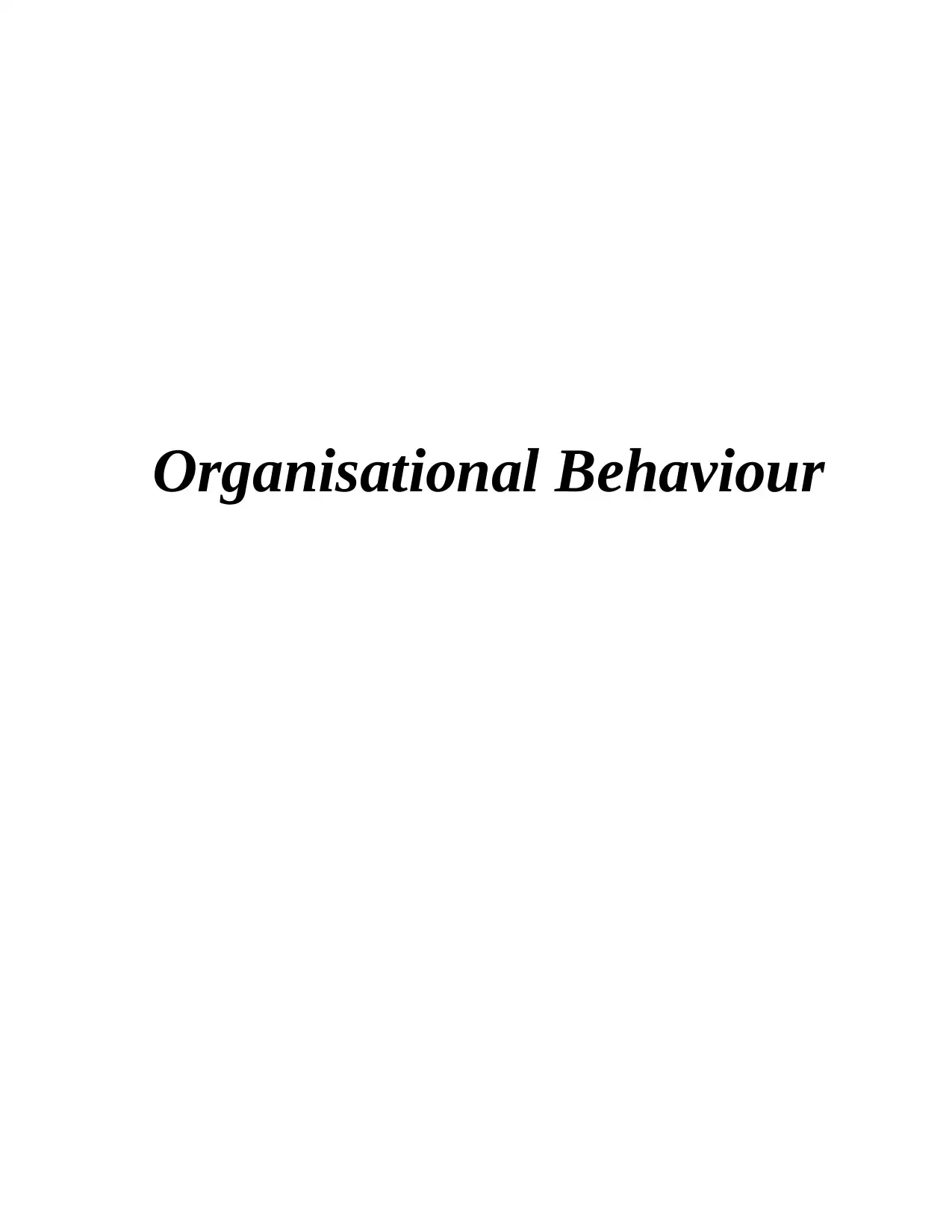
Organisational Behaviour
Paraphrase This Document
Need a fresh take? Get an instant paraphrase of this document with our AI Paraphraser
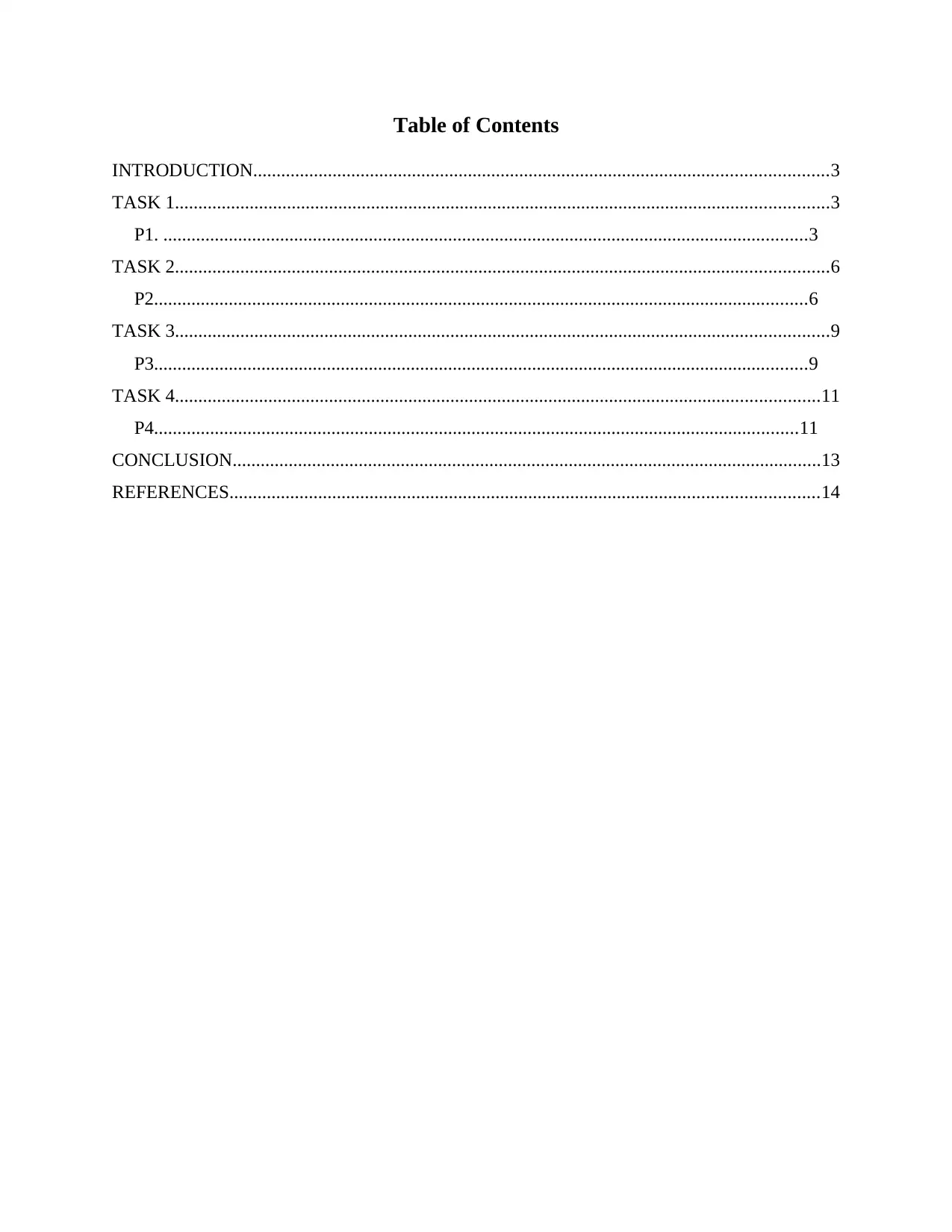
Table of Contents
INTRODUCTION...........................................................................................................................3
TASK 1............................................................................................................................................3
P1. ..........................................................................................................................................3
TASK 2............................................................................................................................................6
P2............................................................................................................................................6
TASK 3............................................................................................................................................9
P3............................................................................................................................................9
TASK 4..........................................................................................................................................11
P4..........................................................................................................................................11
CONCLUSION..............................................................................................................................13
REFERENCES..............................................................................................................................14
INTRODUCTION...........................................................................................................................3
TASK 1............................................................................................................................................3
P1. ..........................................................................................................................................3
TASK 2............................................................................................................................................6
P2............................................................................................................................................6
TASK 3............................................................................................................................................9
P3............................................................................................................................................9
TASK 4..........................................................................................................................................11
P4..........................................................................................................................................11
CONCLUSION..............................................................................................................................13
REFERENCES..............................................................................................................................14
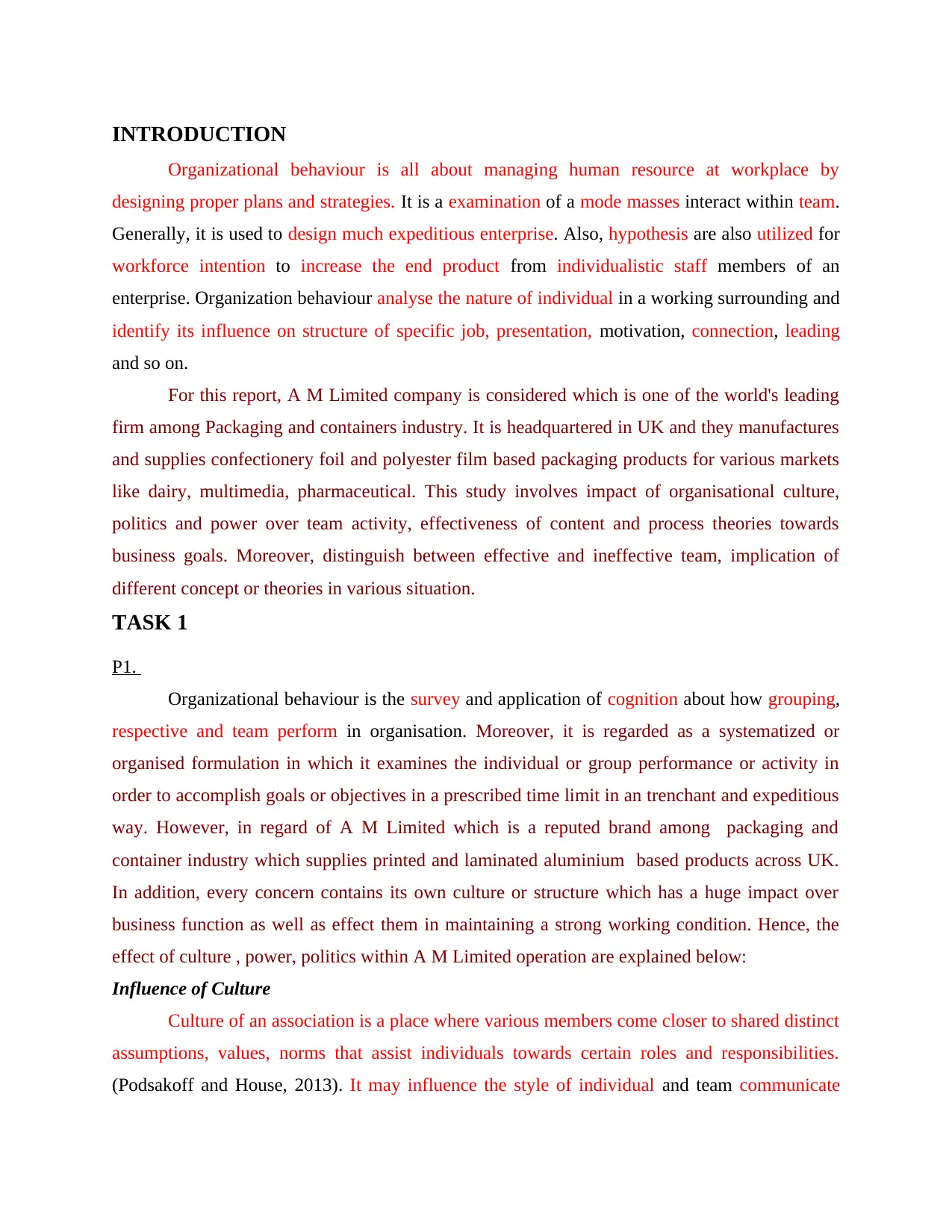
INTRODUCTION
Organizational behaviour is all about managing human resource at workplace by
designing proper plans and strategies. It is a examination of a mode masses interact within team.
Generally, it is used to design much expeditious enterprise. Also, hypothesis are also utilized for
workforce intention to increase the end product from individualistic staff members of an
enterprise. Organization behaviour analyse the nature of individual in a working surrounding and
identify its influence on structure of specific job, presentation, motivation, connection, leading
and so on.
For this report, A M Limited company is considered which is one of the world's leading
firm among Packaging and containers industry. It is headquartered in UK and they manufactures
and supplies confectionery foil and polyester film based packaging products for various markets
like dairy, multimedia, pharmaceutical. This study involves impact of organisational culture,
politics and power over team activity, effectiveness of content and process theories towards
business goals. Moreover, distinguish between effective and ineffective team, implication of
different concept or theories in various situation.
TASK 1
P1.
Organizational behaviour is the survey and application of cognition about how grouping,
respective and team perform in organisation. Moreover, it is regarded as a systematized or
organised formulation in which it examines the individual or group performance or activity in
order to accomplish goals or objectives in a prescribed time limit in an trenchant and expeditious
way. However, in regard of A M Limited which is a reputed brand among packaging and
container industry which supplies printed and laminated aluminium based products across UK.
In addition, every concern contains its own culture or structure which has a huge impact over
business function as well as effect them in maintaining a strong working condition. Hence, the
effect of culture , power, politics within A M Limited operation are explained below:
Influence of Culture
Culture of an association is a place where various members come closer to shared distinct
assumptions, values, norms that assist individuals towards certain roles and responsibilities.
(Podsakoff and House, 2013). It may influence the style of individual and team communicate
Organizational behaviour is all about managing human resource at workplace by
designing proper plans and strategies. It is a examination of a mode masses interact within team.
Generally, it is used to design much expeditious enterprise. Also, hypothesis are also utilized for
workforce intention to increase the end product from individualistic staff members of an
enterprise. Organization behaviour analyse the nature of individual in a working surrounding and
identify its influence on structure of specific job, presentation, motivation, connection, leading
and so on.
For this report, A M Limited company is considered which is one of the world's leading
firm among Packaging and containers industry. It is headquartered in UK and they manufactures
and supplies confectionery foil and polyester film based packaging products for various markets
like dairy, multimedia, pharmaceutical. This study involves impact of organisational culture,
politics and power over team activity, effectiveness of content and process theories towards
business goals. Moreover, distinguish between effective and ineffective team, implication of
different concept or theories in various situation.
TASK 1
P1.
Organizational behaviour is the survey and application of cognition about how grouping,
respective and team perform in organisation. Moreover, it is regarded as a systematized or
organised formulation in which it examines the individual or group performance or activity in
order to accomplish goals or objectives in a prescribed time limit in an trenchant and expeditious
way. However, in regard of A M Limited which is a reputed brand among packaging and
container industry which supplies printed and laminated aluminium based products across UK.
In addition, every concern contains its own culture or structure which has a huge impact over
business function as well as effect them in maintaining a strong working condition. Hence, the
effect of culture , power, politics within A M Limited operation are explained below:
Influence of Culture
Culture of an association is a place where various members come closer to shared distinct
assumptions, values, norms that assist individuals towards certain roles and responsibilities.
(Podsakoff and House, 2013). It may influence the style of individual and team communicate
⊘ This is a preview!⊘
Do you want full access?
Subscribe today to unlock all pages.

Trusted by 1+ million students worldwide
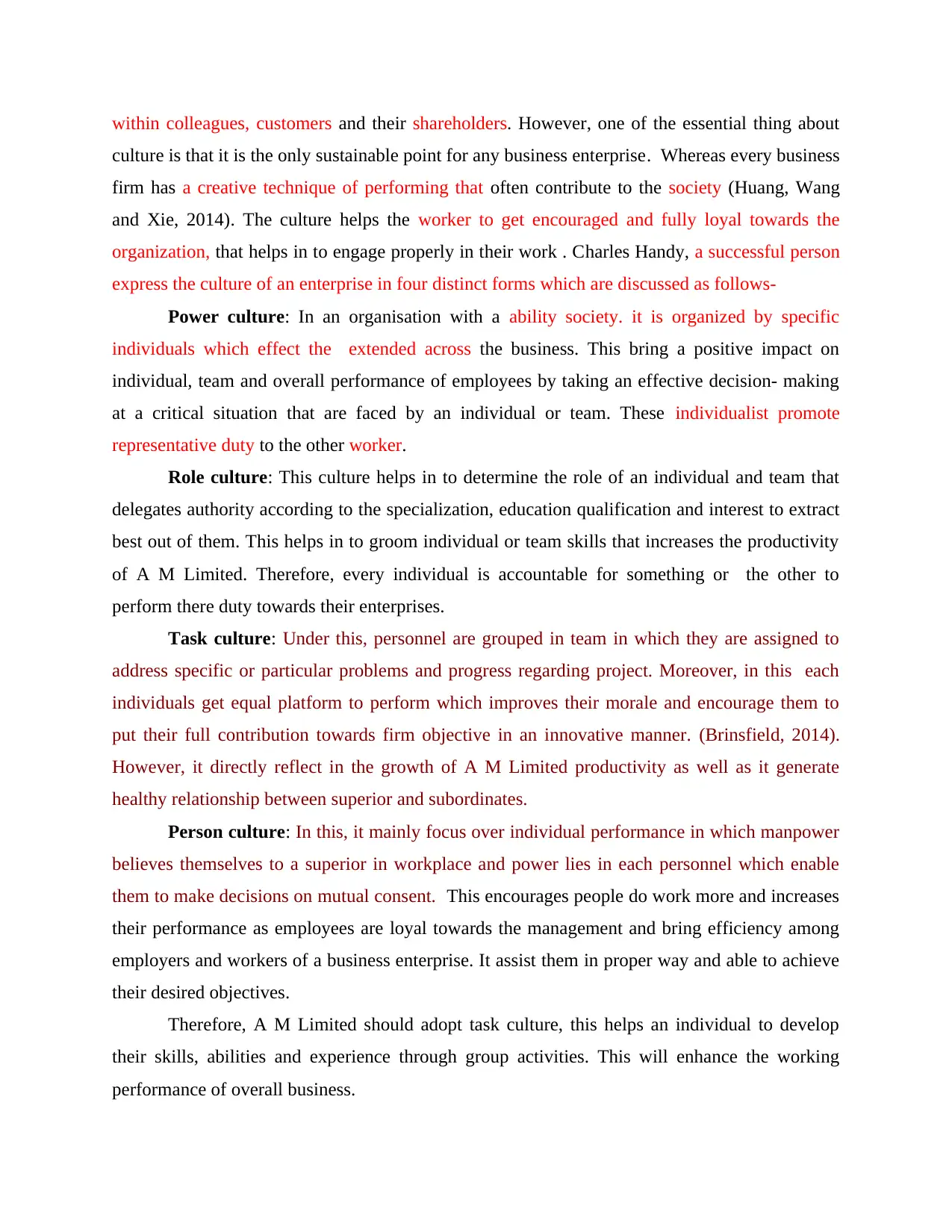
within colleagues, customers and their shareholders. However, one of the essential thing about
culture is that it is the only sustainable point for any business enterprise. Whereas every business
firm has a creative technique of performing that often contribute to the society (Huang, Wang
and Xie, 2014). The culture helps the worker to get encouraged and fully loyal towards the
organization, that helps in to engage properly in their work . Charles Handy, a successful person
express the culture of an enterprise in four distinct forms which are discussed as follows-
Power culture: In an organisation with a ability society. it is organized by specific
individuals which effect the extended across the business. This bring a positive impact on
individual, team and overall performance of employees by taking an effective decision- making
at a critical situation that are faced by an individual or team. These individualist promote
representative duty to the other worker.
Role culture: This culture helps in to determine the role of an individual and team that
delegates authority according to the specialization, education qualification and interest to extract
best out of them. This helps in to groom individual or team skills that increases the productivity
of A M Limited. Therefore, every individual is accountable for something or the other to
perform there duty towards their enterprises.
Task culture: Under this, personnel are grouped in team in which they are assigned to
address specific or particular problems and progress regarding project. Moreover, in this each
individuals get equal platform to perform which improves their morale and encourage them to
put their full contribution towards firm objective in an innovative manner. (Brinsfield, 2014).
However, it directly reflect in the growth of A M Limited productivity as well as it generate
healthy relationship between superior and subordinates.
Person culture: In this, it mainly focus over individual performance in which manpower
believes themselves to a superior in workplace and power lies in each personnel which enable
them to make decisions on mutual consent. This encourages people do work more and increases
their performance as employees are loyal towards the management and bring efficiency among
employers and workers of a business enterprise. It assist them in proper way and able to achieve
their desired objectives.
Therefore, A M Limited should adopt task culture, this helps an individual to develop
their skills, abilities and experience through group activities. This will enhance the working
performance of overall business.
culture is that it is the only sustainable point for any business enterprise. Whereas every business
firm has a creative technique of performing that often contribute to the society (Huang, Wang
and Xie, 2014). The culture helps the worker to get encouraged and fully loyal towards the
organization, that helps in to engage properly in their work . Charles Handy, a successful person
express the culture of an enterprise in four distinct forms which are discussed as follows-
Power culture: In an organisation with a ability society. it is organized by specific
individuals which effect the extended across the business. This bring a positive impact on
individual, team and overall performance of employees by taking an effective decision- making
at a critical situation that are faced by an individual or team. These individualist promote
representative duty to the other worker.
Role culture: This culture helps in to determine the role of an individual and team that
delegates authority according to the specialization, education qualification and interest to extract
best out of them. This helps in to groom individual or team skills that increases the productivity
of A M Limited. Therefore, every individual is accountable for something or the other to
perform there duty towards their enterprises.
Task culture: Under this, personnel are grouped in team in which they are assigned to
address specific or particular problems and progress regarding project. Moreover, in this each
individuals get equal platform to perform which improves their morale and encourage them to
put their full contribution towards firm objective in an innovative manner. (Brinsfield, 2014).
However, it directly reflect in the growth of A M Limited productivity as well as it generate
healthy relationship between superior and subordinates.
Person culture: In this, it mainly focus over individual performance in which manpower
believes themselves to a superior in workplace and power lies in each personnel which enable
them to make decisions on mutual consent. This encourages people do work more and increases
their performance as employees are loyal towards the management and bring efficiency among
employers and workers of a business enterprise. It assist them in proper way and able to achieve
their desired objectives.
Therefore, A M Limited should adopt task culture, this helps an individual to develop
their skills, abilities and experience through group activities. This will enhance the working
performance of overall business.
Paraphrase This Document
Need a fresh take? Get an instant paraphrase of this document with our AI Paraphraser
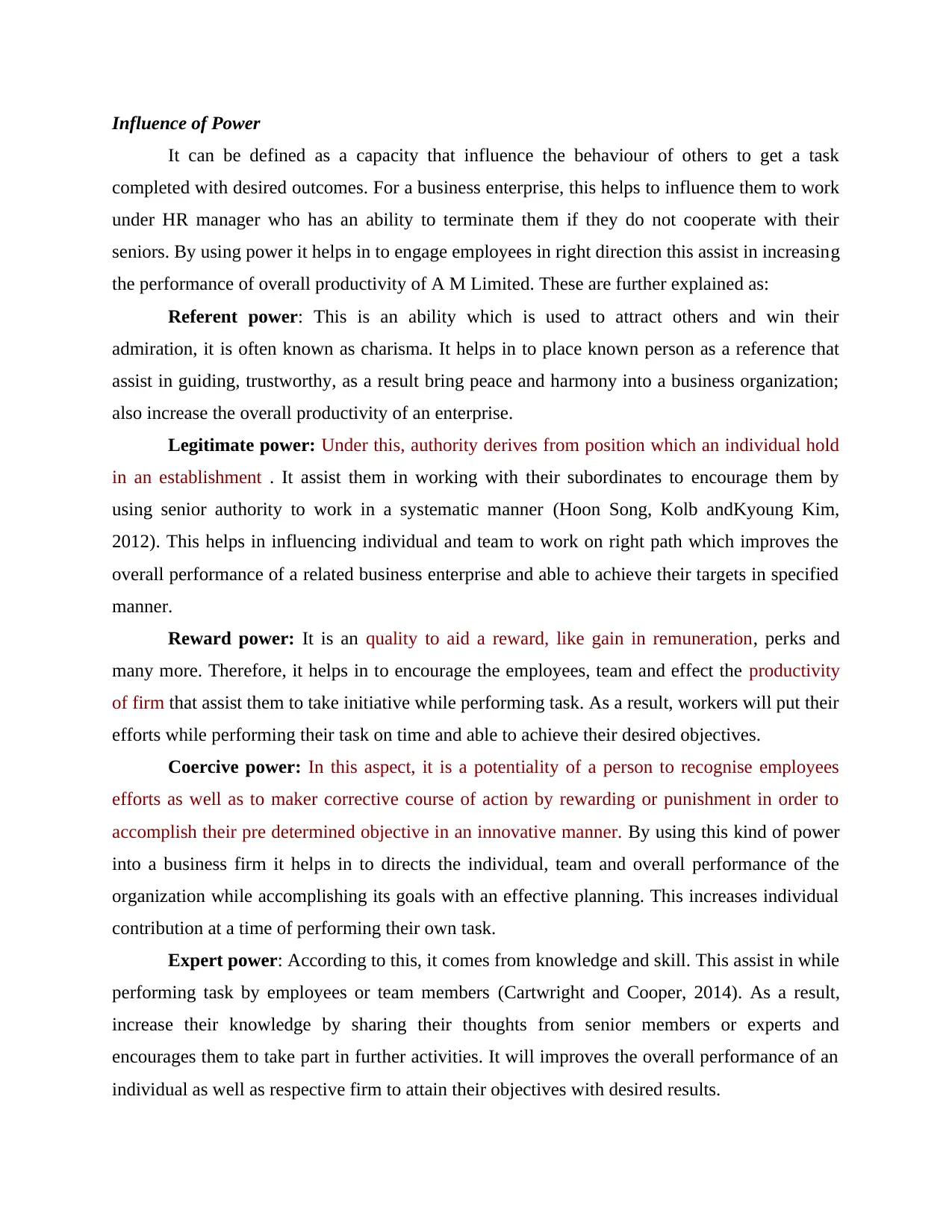
Influence of Power
It can be defined as a capacity that influence the behaviour of others to get a task
completed with desired outcomes. For a business enterprise, this helps to influence them to work
under HR manager who has an ability to terminate them if they do not cooperate with their
seniors. By using power it helps in to engage employees in right direction this assist in increasing
the performance of overall productivity of A M Limited. These are further explained as:
Referent power: This is an ability which is used to attract others and win their
admiration, it is often known as charisma. It helps in to place known person as a reference that
assist in guiding, trustworthy, as a result bring peace and harmony into a business organization;
also increase the overall productivity of an enterprise.
Legitimate power: Under this, authority derives from position which an individual hold
in an establishment . It assist them in working with their subordinates to encourage them by
using senior authority to work in a systematic manner (Hoon Song, Kolb andKyoung Kim,
2012). This helps in influencing individual and team to work on right path which improves the
overall performance of a related business enterprise and able to achieve their targets in specified
manner.
Reward power: It is an quality to aid a reward, like gain in remuneration, perks and
many more. Therefore, it helps in to encourage the employees, team and effect the productivity
of firm that assist them to take initiative while performing task. As a result, workers will put their
efforts while performing their task on time and able to achieve their desired objectives.
Coercive power: In this aspect, it is a potentiality of a person to recognise employees
efforts as well as to maker corrective course of action by rewarding or punishment in order to
accomplish their pre determined objective in an innovative manner. By using this kind of power
into a business firm it helps in to directs the individual, team and overall performance of the
organization while accomplishing its goals with an effective planning. This increases individual
contribution at a time of performing their own task.
Expert power: According to this, it comes from knowledge and skill. This assist in while
performing task by employees or team members (Cartwright and Cooper, 2014). As a result,
increase their knowledge by sharing their thoughts from senior members or experts and
encourages them to take part in further activities. It will improves the overall performance of an
individual as well as respective firm to attain their objectives with desired results.
It can be defined as a capacity that influence the behaviour of others to get a task
completed with desired outcomes. For a business enterprise, this helps to influence them to work
under HR manager who has an ability to terminate them if they do not cooperate with their
seniors. By using power it helps in to engage employees in right direction this assist in increasing
the performance of overall productivity of A M Limited. These are further explained as:
Referent power: This is an ability which is used to attract others and win their
admiration, it is often known as charisma. It helps in to place known person as a reference that
assist in guiding, trustworthy, as a result bring peace and harmony into a business organization;
also increase the overall productivity of an enterprise.
Legitimate power: Under this, authority derives from position which an individual hold
in an establishment . It assist them in working with their subordinates to encourage them by
using senior authority to work in a systematic manner (Hoon Song, Kolb andKyoung Kim,
2012). This helps in influencing individual and team to work on right path which improves the
overall performance of a related business enterprise and able to achieve their targets in specified
manner.
Reward power: It is an quality to aid a reward, like gain in remuneration, perks and
many more. Therefore, it helps in to encourage the employees, team and effect the productivity
of firm that assist them to take initiative while performing task. As a result, workers will put their
efforts while performing their task on time and able to achieve their desired objectives.
Coercive power: In this aspect, it is a potentiality of a person to recognise employees
efforts as well as to maker corrective course of action by rewarding or punishment in order to
accomplish their pre determined objective in an innovative manner. By using this kind of power
into a business firm it helps in to directs the individual, team and overall performance of the
organization while accomplishing its goals with an effective planning. This increases individual
contribution at a time of performing their own task.
Expert power: According to this, it comes from knowledge and skill. This assist in while
performing task by employees or team members (Cartwright and Cooper, 2014). As a result,
increase their knowledge by sharing their thoughts from senior members or experts and
encourages them to take part in further activities. It will improves the overall performance of an
individual as well as respective firm to attain their objectives with desired results.
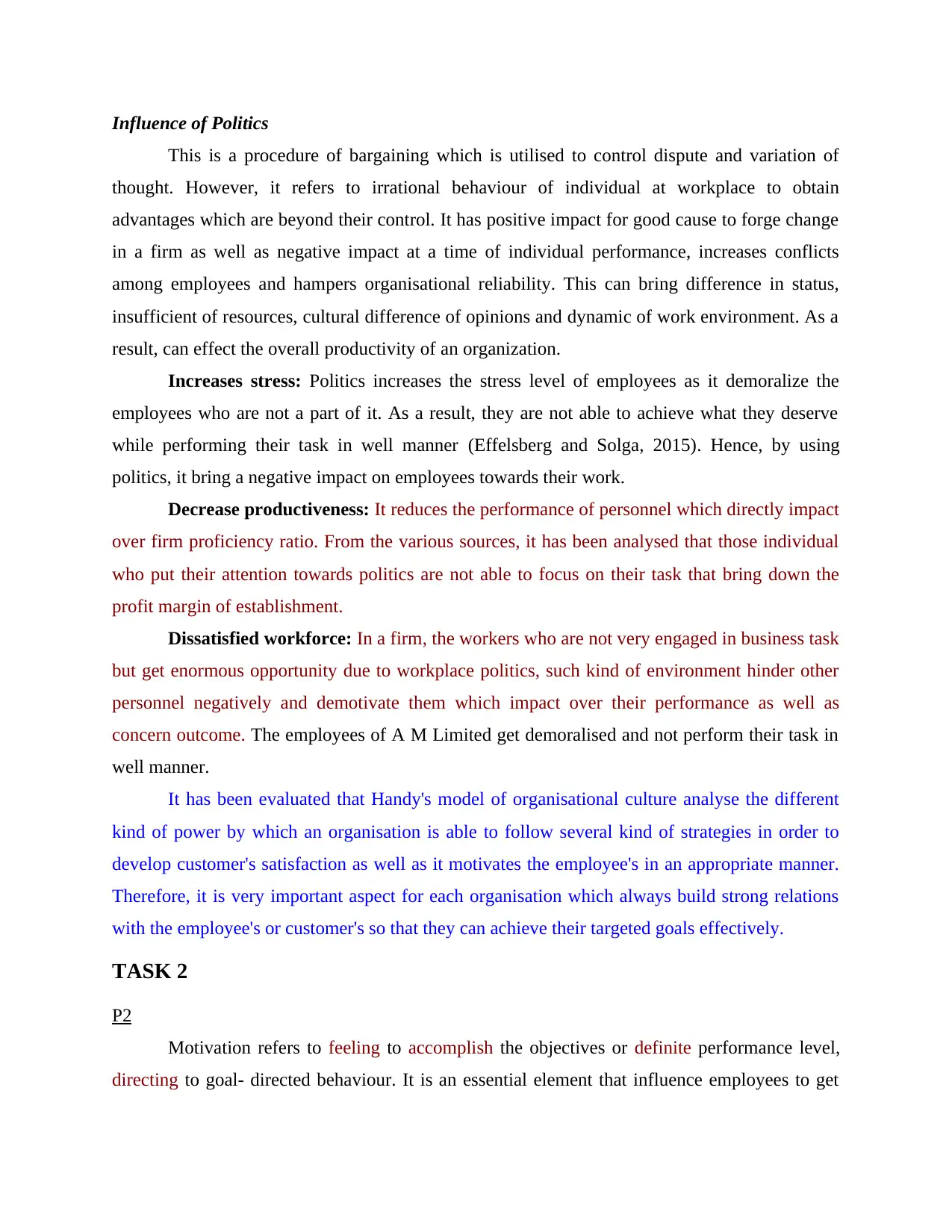
Influence of Politics
This is a procedure of bargaining which is utilised to control dispute and variation of
thought. However, it refers to irrational behaviour of individual at workplace to obtain
advantages which are beyond their control. It has positive impact for good cause to forge change
in a firm as well as negative impact at a time of individual performance, increases conflicts
among employees and hampers organisational reliability. This can bring difference in status,
insufficient of resources, cultural difference of opinions and dynamic of work environment. As a
result, can effect the overall productivity of an organization.
Increases stress: Politics increases the stress level of employees as it demoralize the
employees who are not a part of it. As a result, they are not able to achieve what they deserve
while performing their task in well manner (Effelsberg and Solga, 2015). Hence, by using
politics, it bring a negative impact on employees towards their work.
Decrease productiveness: It reduces the performance of personnel which directly impact
over firm proficiency ratio. From the various sources, it has been analysed that those individual
who put their attention towards politics are not able to focus on their task that bring down the
profit margin of establishment.
Dissatisfied workforce: In a firm, the workers who are not very engaged in business task
but get enormous opportunity due to workplace politics, such kind of environment hinder other
personnel negatively and demotivate them which impact over their performance as well as
concern outcome. The employees of A M Limited get demoralised and not perform their task in
well manner.
It has been evaluated that Handy's model of organisational culture analyse the different
kind of power by which an organisation is able to follow several kind of strategies in order to
develop customer's satisfaction as well as it motivates the employee's in an appropriate manner.
Therefore, it is very important aspect for each organisation which always build strong relations
with the employee's or customer's so that they can achieve their targeted goals effectively.
TASK 2
P2
Motivation refers to feeling to accomplish the objectives or definite performance level,
directing to goal- directed behaviour. It is an essential element that influence employees to get
This is a procedure of bargaining which is utilised to control dispute and variation of
thought. However, it refers to irrational behaviour of individual at workplace to obtain
advantages which are beyond their control. It has positive impact for good cause to forge change
in a firm as well as negative impact at a time of individual performance, increases conflicts
among employees and hampers organisational reliability. This can bring difference in status,
insufficient of resources, cultural difference of opinions and dynamic of work environment. As a
result, can effect the overall productivity of an organization.
Increases stress: Politics increases the stress level of employees as it demoralize the
employees who are not a part of it. As a result, they are not able to achieve what they deserve
while performing their task in well manner (Effelsberg and Solga, 2015). Hence, by using
politics, it bring a negative impact on employees towards their work.
Decrease productiveness: It reduces the performance of personnel which directly impact
over firm proficiency ratio. From the various sources, it has been analysed that those individual
who put their attention towards politics are not able to focus on their task that bring down the
profit margin of establishment.
Dissatisfied workforce: In a firm, the workers who are not very engaged in business task
but get enormous opportunity due to workplace politics, such kind of environment hinder other
personnel negatively and demotivate them which impact over their performance as well as
concern outcome. The employees of A M Limited get demoralised and not perform their task in
well manner.
It has been evaluated that Handy's model of organisational culture analyse the different
kind of power by which an organisation is able to follow several kind of strategies in order to
develop customer's satisfaction as well as it motivates the employee's in an appropriate manner.
Therefore, it is very important aspect for each organisation which always build strong relations
with the employee's or customer's so that they can achieve their targeted goals effectively.
TASK 2
P2
Motivation refers to feeling to accomplish the objectives or definite performance level,
directing to goal- directed behaviour. It is an essential element that influence employees to get
⊘ This is a preview!⊘
Do you want full access?
Subscribe today to unlock all pages.

Trusted by 1+ million students worldwide
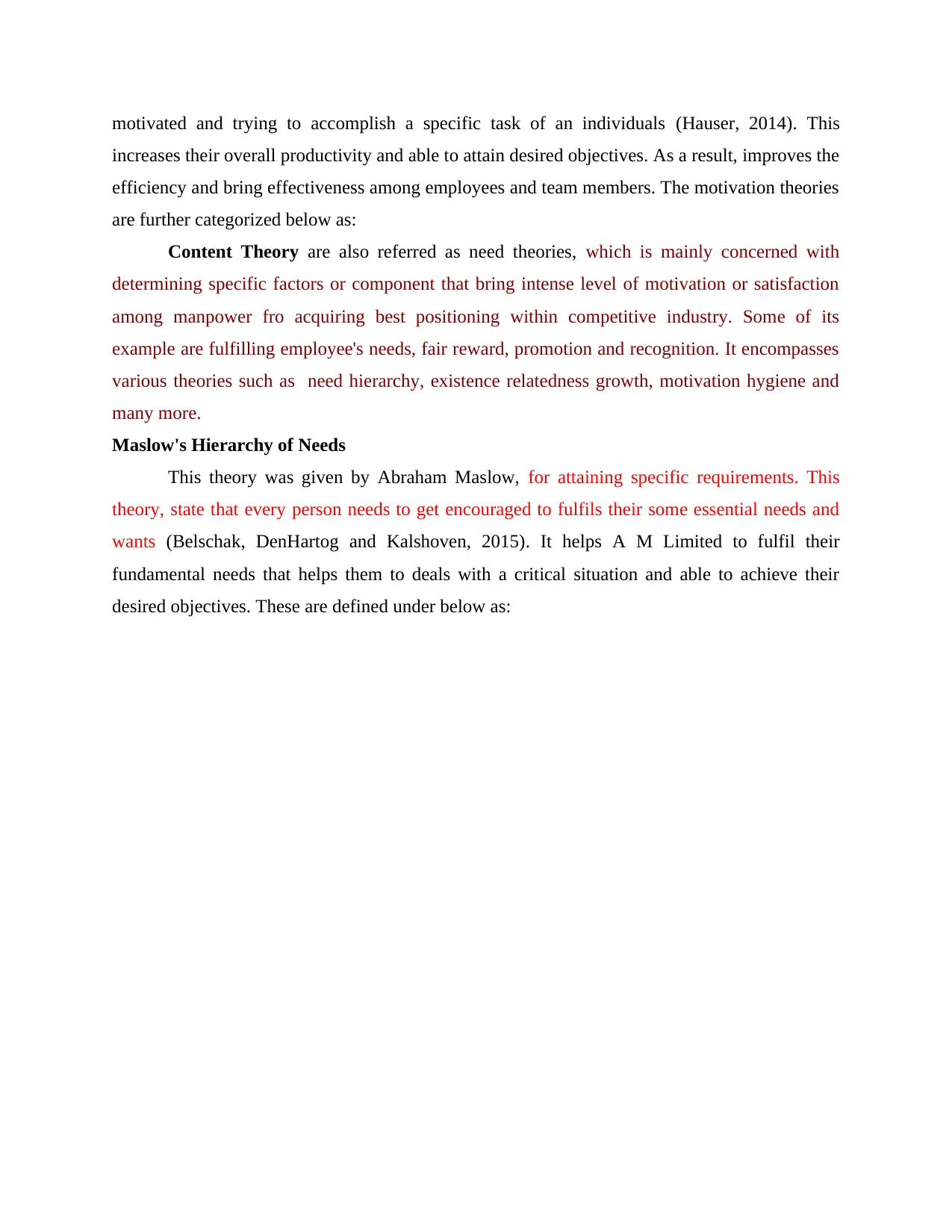
motivated and trying to accomplish a specific task of an individuals (Hauser, 2014). This
increases their overall productivity and able to attain desired objectives. As a result, improves the
efficiency and bring effectiveness among employees and team members. The motivation theories
are further categorized below as:
Content Theory are also referred as need theories, which is mainly concerned with
determining specific factors or component that bring intense level of motivation or satisfaction
among manpower fro acquiring best positioning within competitive industry. Some of its
example are fulfilling employee's needs, fair reward, promotion and recognition. It encompasses
various theories such as need hierarchy, existence relatedness growth, motivation hygiene and
many more.
Maslow's Hierarchy of Needs
This theory was given by Abraham Maslow, for attaining specific requirements. This
theory, state that every person needs to get encouraged to fulfils their some essential needs and
wants (Belschak, DenHartog and Kalshoven, 2015). It helps A M Limited to fulfil their
fundamental needs that helps them to deals with a critical situation and able to achieve their
desired objectives. These are defined under below as:
increases their overall productivity and able to attain desired objectives. As a result, improves the
efficiency and bring effectiveness among employees and team members. The motivation theories
are further categorized below as:
Content Theory are also referred as need theories, which is mainly concerned with
determining specific factors or component that bring intense level of motivation or satisfaction
among manpower fro acquiring best positioning within competitive industry. Some of its
example are fulfilling employee's needs, fair reward, promotion and recognition. It encompasses
various theories such as need hierarchy, existence relatedness growth, motivation hygiene and
many more.
Maslow's Hierarchy of Needs
This theory was given by Abraham Maslow, for attaining specific requirements. This
theory, state that every person needs to get encouraged to fulfils their some essential needs and
wants (Belschak, DenHartog and Kalshoven, 2015). It helps A M Limited to fulfil their
fundamental needs that helps them to deals with a critical situation and able to achieve their
desired objectives. These are defined under below as:
Paraphrase This Document
Need a fresh take? Get an instant paraphrase of this document with our AI Paraphraser
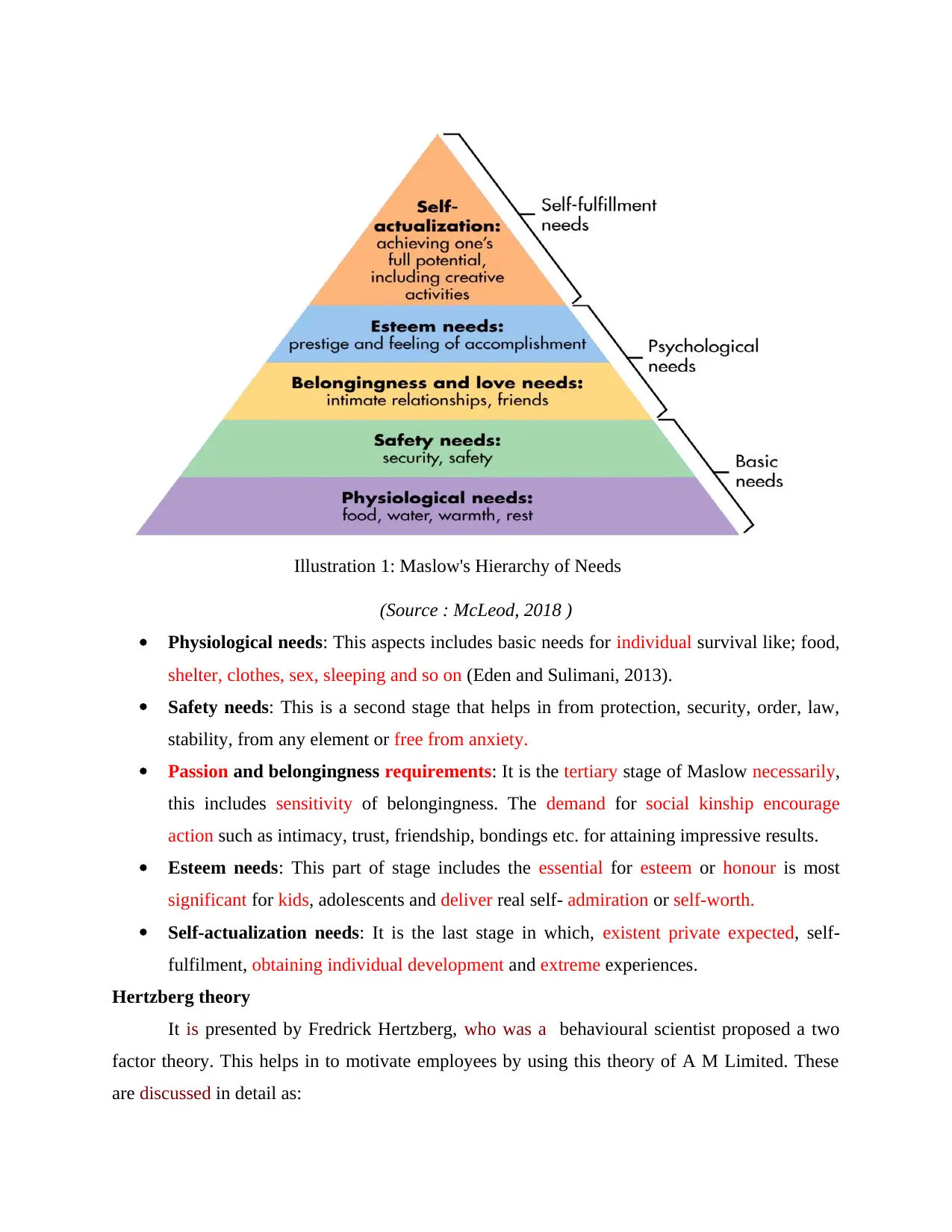
(Source : McLeod, 2018 )
Physiological needs: This aspects includes basic needs for individual survival like; food,
shelter, clothes, sex, sleeping and so on (Eden and Sulimani, 2013).
Safety needs: This is a second stage that helps in from protection, security, order, law,
stability, from any element or free from anxiety.
Passion and belongingness requirements: It is the tertiary stage of Maslow necessarily,
this includes sensitivity of belongingness. The demand for social kinship encourage
action such as intimacy, trust, friendship, bondings etc. for attaining impressive results.
Esteem needs: This part of stage includes the essential for esteem or honour is most
significant for kids, adolescents and deliver real self- admiration or self-worth.
Self-actualization needs: It is the last stage in which, existent private expected, self-
fulfilment, obtaining individual development and extreme experiences.
Hertzberg theory
It is presented by Fredrick Hertzberg, who was a behavioural scientist proposed a two
factor theory. This helps in to motivate employees by using this theory of A M Limited. These
are discussed in detail as:
Illustration 1: Maslow's Hierarchy of Needs
Physiological needs: This aspects includes basic needs for individual survival like; food,
shelter, clothes, sex, sleeping and so on (Eden and Sulimani, 2013).
Safety needs: This is a second stage that helps in from protection, security, order, law,
stability, from any element or free from anxiety.
Passion and belongingness requirements: It is the tertiary stage of Maslow necessarily,
this includes sensitivity of belongingness. The demand for social kinship encourage
action such as intimacy, trust, friendship, bondings etc. for attaining impressive results.
Esteem needs: This part of stage includes the essential for esteem or honour is most
significant for kids, adolescents and deliver real self- admiration or self-worth.
Self-actualization needs: It is the last stage in which, existent private expected, self-
fulfilment, obtaining individual development and extreme experiences.
Hertzberg theory
It is presented by Fredrick Hertzberg, who was a behavioural scientist proposed a two
factor theory. This helps in to motivate employees by using this theory of A M Limited. These
are discussed in detail as:
Illustration 1: Maslow's Hierarchy of Needs
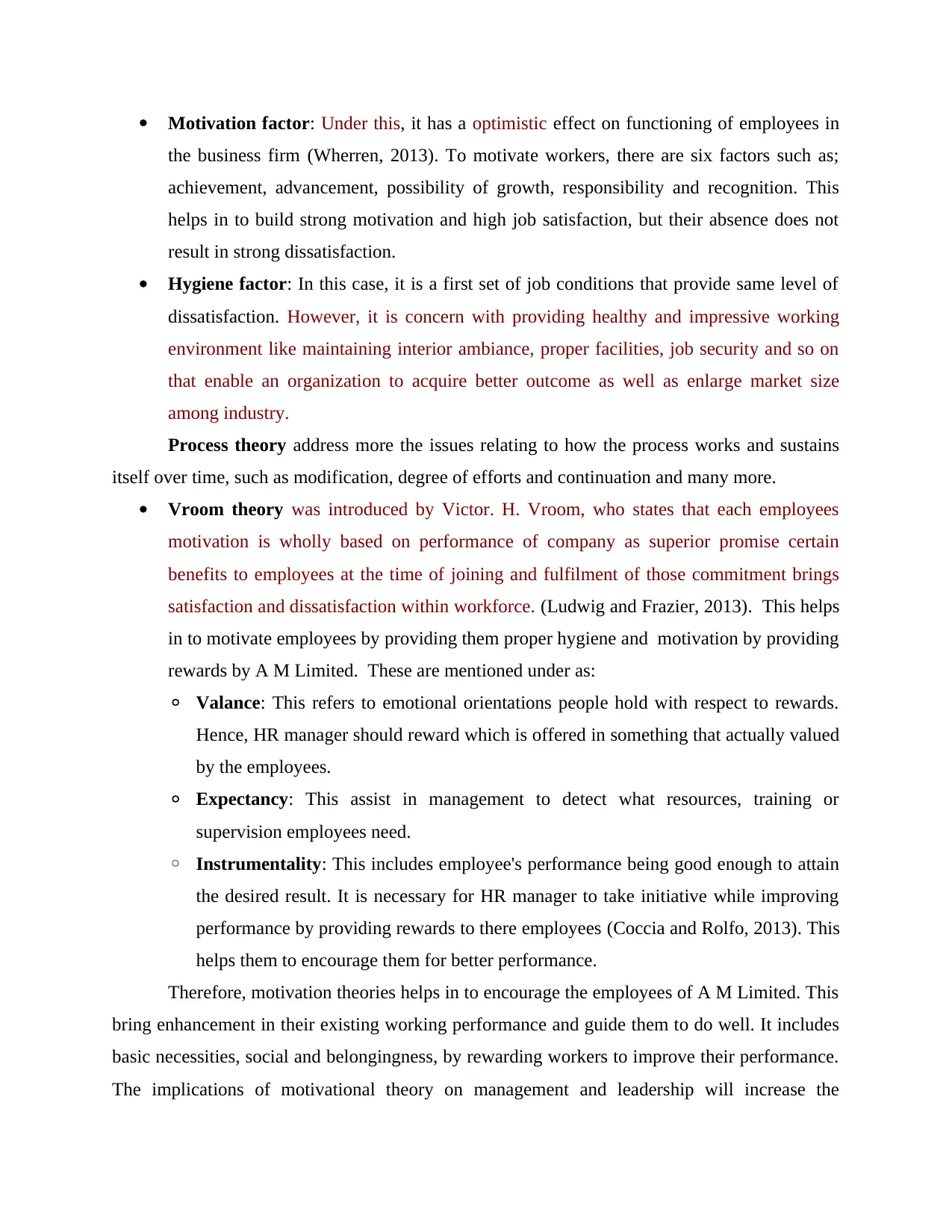
Motivation factor: Under this, it has a optimistic effect on functioning of employees in
the business firm (Wherren, 2013). To motivate workers, there are six factors such as;
achievement, advancement, possibility of growth, responsibility and recognition. This
helps in to build strong motivation and high job satisfaction, but their absence does not
result in strong dissatisfaction.
Hygiene factor: In this case, it is a first set of job conditions that provide same level of
dissatisfaction. However, it is concern with providing healthy and impressive working
environment like maintaining interior ambiance, proper facilities, job security and so on
that enable an organization to acquire better outcome as well as enlarge market size
among industry.
Process theory address more the issues relating to how the process works and sustains
itself over time, such as modification, degree of efforts and continuation and many more.
Vroom theory was introduced by Victor. H. Vroom, who states that each employees
motivation is wholly based on performance of company as superior promise certain
benefits to employees at the time of joining and fulfilment of those commitment brings
satisfaction and dissatisfaction within workforce. (Ludwig and Frazier, 2013). This helps
in to motivate employees by providing them proper hygiene and motivation by providing
rewards by A M Limited. These are mentioned under as:
◦ Valance: This refers to emotional orientations people hold with respect to rewards.
Hence, HR manager should reward which is offered in something that actually valued
by the employees.
◦ Expectancy: This assist in management to detect what resources, training or
supervision employees need.
◦ Instrumentality: This includes employee's performance being good enough to attain
the desired result. It is necessary for HR manager to take initiative while improving
performance by providing rewards to there employees (Coccia and Rolfo, 2013). This
helps them to encourage them for better performance.
Therefore, motivation theories helps in to encourage the employees of A M Limited. This
bring enhancement in their existing working performance and guide them to do well. It includes
basic necessities, social and belongingness, by rewarding workers to improve their performance.
The implications of motivational theory on management and leadership will increase the
the business firm (Wherren, 2013). To motivate workers, there are six factors such as;
achievement, advancement, possibility of growth, responsibility and recognition. This
helps in to build strong motivation and high job satisfaction, but their absence does not
result in strong dissatisfaction.
Hygiene factor: In this case, it is a first set of job conditions that provide same level of
dissatisfaction. However, it is concern with providing healthy and impressive working
environment like maintaining interior ambiance, proper facilities, job security and so on
that enable an organization to acquire better outcome as well as enlarge market size
among industry.
Process theory address more the issues relating to how the process works and sustains
itself over time, such as modification, degree of efforts and continuation and many more.
Vroom theory was introduced by Victor. H. Vroom, who states that each employees
motivation is wholly based on performance of company as superior promise certain
benefits to employees at the time of joining and fulfilment of those commitment brings
satisfaction and dissatisfaction within workforce. (Ludwig and Frazier, 2013). This helps
in to motivate employees by providing them proper hygiene and motivation by providing
rewards by A M Limited. These are mentioned under as:
◦ Valance: This refers to emotional orientations people hold with respect to rewards.
Hence, HR manager should reward which is offered in something that actually valued
by the employees.
◦ Expectancy: This assist in management to detect what resources, training or
supervision employees need.
◦ Instrumentality: This includes employee's performance being good enough to attain
the desired result. It is necessary for HR manager to take initiative while improving
performance by providing rewards to there employees (Coccia and Rolfo, 2013). This
helps them to encourage them for better performance.
Therefore, motivation theories helps in to encourage the employees of A M Limited. This
bring enhancement in their existing working performance and guide them to do well. It includes
basic necessities, social and belongingness, by rewarding workers to improve their performance.
The implications of motivational theory on management and leadership will increase the
⊘ This is a preview!⊘
Do you want full access?
Subscribe today to unlock all pages.

Trusted by 1+ million students worldwide
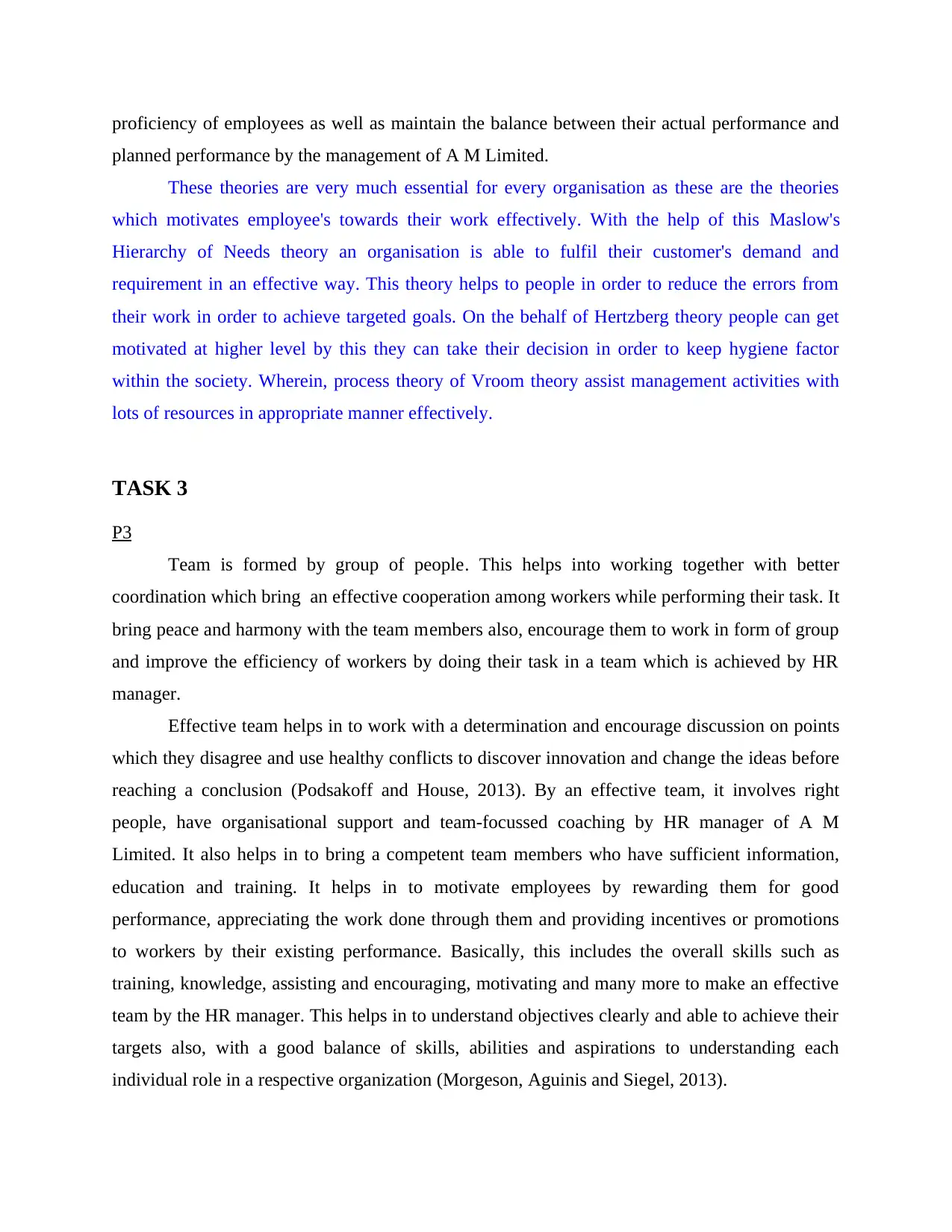
proficiency of employees as well as maintain the balance between their actual performance and
planned performance by the management of A M Limited.
These theories are very much essential for every organisation as these are the theories
which motivates employee's towards their work effectively. With the help of this Maslow's
Hierarchy of Needs theory an organisation is able to fulfil their customer's demand and
requirement in an effective way. This theory helps to people in order to reduce the errors from
their work in order to achieve targeted goals. On the behalf of Hertzberg theory people can get
motivated at higher level by this they can take their decision in order to keep hygiene factor
within the society. Wherein, process theory of Vroom theory assist management activities with
lots of resources in appropriate manner effectively.
TASK 3
P3
Team is formed by group of people. This helps into working together with better
coordination which bring an effective cooperation among workers while performing their task. It
bring peace and harmony with the team members also, encourage them to work in form of group
and improve the efficiency of workers by doing their task in a team which is achieved by HR
manager.
Effective team helps in to work with a determination and encourage discussion on points
which they disagree and use healthy conflicts to discover innovation and change the ideas before
reaching a conclusion (Podsakoff and House, 2013). By an effective team, it involves right
people, have organisational support and team-focussed coaching by HR manager of A M
Limited. It also helps in to bring a competent team members who have sufficient information,
education and training. It helps in to motivate employees by rewarding them for good
performance, appreciating the work done through them and providing incentives or promotions
to workers by their existing performance. Basically, this includes the overall skills such as
training, knowledge, assisting and encouraging, motivating and many more to make an effective
team by the HR manager. This helps in to understand objectives clearly and able to achieve their
targets also, with a good balance of skills, abilities and aspirations to understanding each
individual role in a respective organization (Morgeson, Aguinis and Siegel, 2013).
planned performance by the management of A M Limited.
These theories are very much essential for every organisation as these are the theories
which motivates employee's towards their work effectively. With the help of this Maslow's
Hierarchy of Needs theory an organisation is able to fulfil their customer's demand and
requirement in an effective way. This theory helps to people in order to reduce the errors from
their work in order to achieve targeted goals. On the behalf of Hertzberg theory people can get
motivated at higher level by this they can take their decision in order to keep hygiene factor
within the society. Wherein, process theory of Vroom theory assist management activities with
lots of resources in appropriate manner effectively.
TASK 3
P3
Team is formed by group of people. This helps into working together with better
coordination which bring an effective cooperation among workers while performing their task. It
bring peace and harmony with the team members also, encourage them to work in form of group
and improve the efficiency of workers by doing their task in a team which is achieved by HR
manager.
Effective team helps in to work with a determination and encourage discussion on points
which they disagree and use healthy conflicts to discover innovation and change the ideas before
reaching a conclusion (Podsakoff and House, 2013). By an effective team, it involves right
people, have organisational support and team-focussed coaching by HR manager of A M
Limited. It also helps in to bring a competent team members who have sufficient information,
education and training. It helps in to motivate employees by rewarding them for good
performance, appreciating the work done through them and providing incentives or promotions
to workers by their existing performance. Basically, this includes the overall skills such as
training, knowledge, assisting and encouraging, motivating and many more to make an effective
team by the HR manager. This helps in to understand objectives clearly and able to achieve their
targets also, with a good balance of skills, abilities and aspirations to understanding each
individual role in a respective organization (Morgeson, Aguinis and Siegel, 2013).
Paraphrase This Document
Need a fresh take? Get an instant paraphrase of this document with our AI Paraphraser
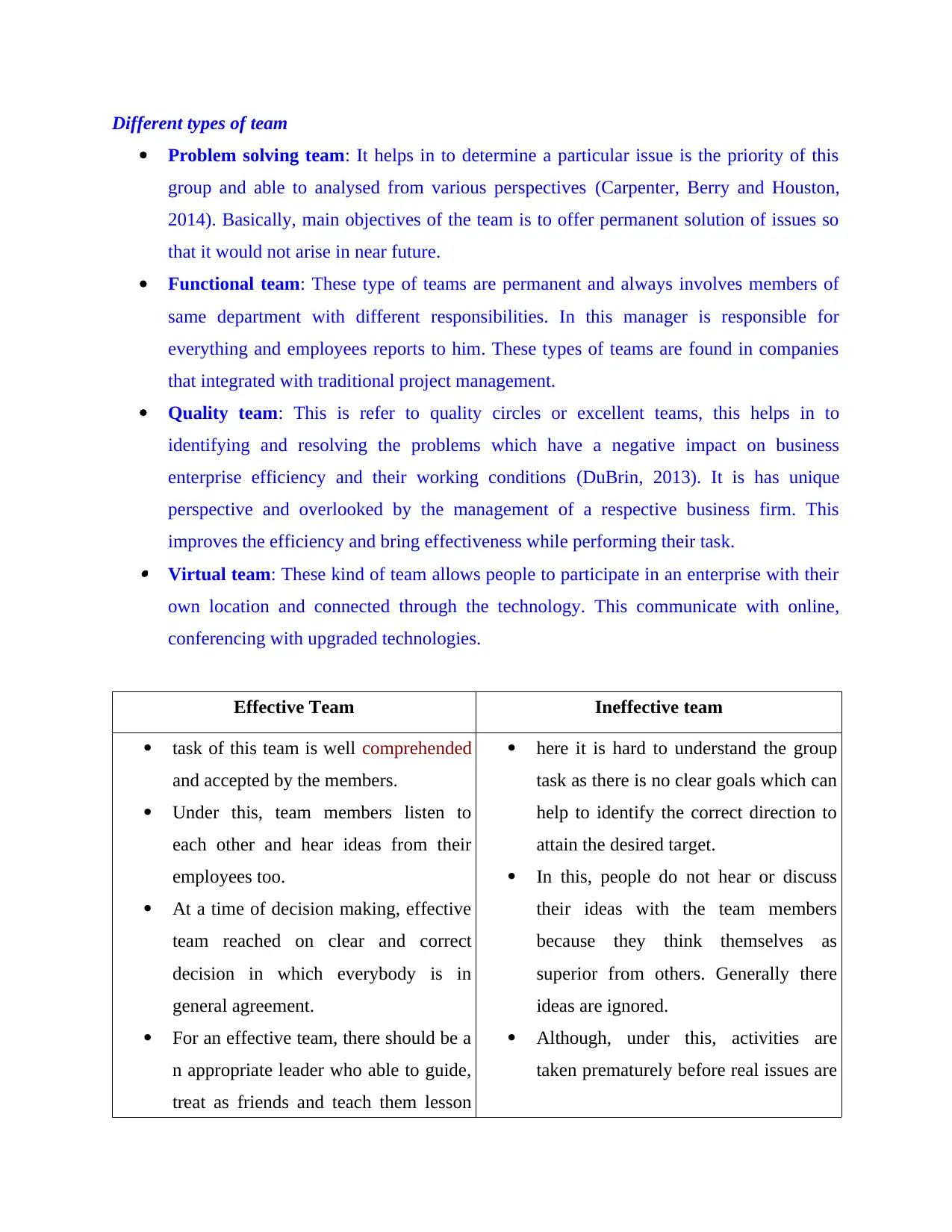
Different types of team
Problem solving team: It helps in to determine a particular issue is the priority of this
group and able to analysed from various perspectives (Carpenter, Berry and Houston,
2014). Basically, main objectives of the team is to offer permanent solution of issues so
that it would not arise in near future.
Functional team: These type of teams are permanent and always involves members of
same department with different responsibilities. In this manager is responsible for
everything and employees reports to him. These types of teams are found in companies
that integrated with traditional project management.
Quality team: This is refer to quality circles or excellent teams, this helps in to
identifying and resolving the problems which have a negative impact on business
enterprise efficiency and their working conditions (DuBrin, 2013). It is has unique
perspective and overlooked by the management of a respective business firm. This
improves the efficiency and bring effectiveness while performing their task. Virtual team: These kind of team allows people to participate in an enterprise with their
own location and connected through the technology. This communicate with online,
conferencing with upgraded technologies.
Effective Team Ineffective team
task of this team is well comprehended
and accepted by the members.
Under this, team members listen to
each other and hear ideas from their
employees too.
At a time of decision making, effective
team reached on clear and correct
decision in which everybody is in
general agreement.
For an effective team, there should be a
n appropriate leader who able to guide,
treat as friends and teach them lesson
here it is hard to understand the group
task as there is no clear goals which can
help to identify the correct direction to
attain the desired target.
In this, people do not hear or discuss
their ideas with the team members
because they think themselves as
superior from others. Generally there
ideas are ignored.
Although, under this, activities are
taken prematurely before real issues are
Problem solving team: It helps in to determine a particular issue is the priority of this
group and able to analysed from various perspectives (Carpenter, Berry and Houston,
2014). Basically, main objectives of the team is to offer permanent solution of issues so
that it would not arise in near future.
Functional team: These type of teams are permanent and always involves members of
same department with different responsibilities. In this manager is responsible for
everything and employees reports to him. These types of teams are found in companies
that integrated with traditional project management.
Quality team: This is refer to quality circles or excellent teams, this helps in to
identifying and resolving the problems which have a negative impact on business
enterprise efficiency and their working conditions (DuBrin, 2013). It is has unique
perspective and overlooked by the management of a respective business firm. This
improves the efficiency and bring effectiveness while performing their task. Virtual team: These kind of team allows people to participate in an enterprise with their
own location and connected through the technology. This communicate with online,
conferencing with upgraded technologies.
Effective Team Ineffective team
task of this team is well comprehended
and accepted by the members.
Under this, team members listen to
each other and hear ideas from their
employees too.
At a time of decision making, effective
team reached on clear and correct
decision in which everybody is in
general agreement.
For an effective team, there should be a
n appropriate leader who able to guide,
treat as friends and teach them lesson
here it is hard to understand the group
task as there is no clear goals which can
help to identify the correct direction to
attain the desired target.
In this, people do not hear or discuss
their ideas with the team members
because they think themselves as
superior from others. Generally there
ideas are ignored.
Although, under this, activities are
taken prematurely before real issues are
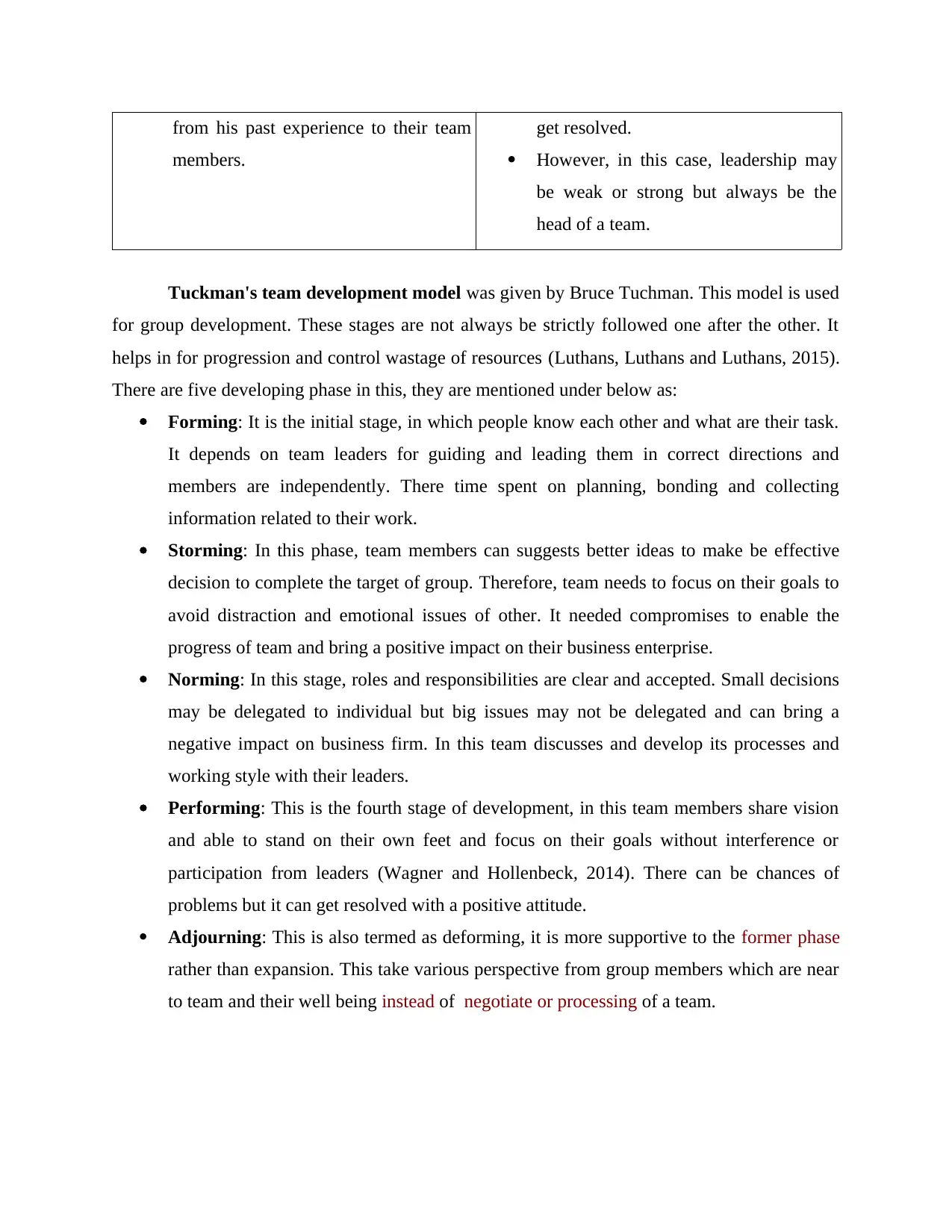
from his past experience to their team
members.
get resolved.
However, in this case, leadership may
be weak or strong but always be the
head of a team.
Tuckman's team development model was given by Bruce Tuchman. This model is used
for group development. These stages are not always be strictly followed one after the other. It
helps in for progression and control wastage of resources (Luthans, Luthans and Luthans, 2015).
There are five developing phase in this, they are mentioned under below as:
Forming: It is the initial stage, in which people know each other and what are their task.
It depends on team leaders for guiding and leading them in correct directions and
members are independently. There time spent on planning, bonding and collecting
information related to their work.
Storming: In this phase, team members can suggests better ideas to make be effective
decision to complete the target of group. Therefore, team needs to focus on their goals to
avoid distraction and emotional issues of other. It needed compromises to enable the
progress of team and bring a positive impact on their business enterprise.
Norming: In this stage, roles and responsibilities are clear and accepted. Small decisions
may be delegated to individual but big issues may not be delegated and can bring a
negative impact on business firm. In this team discusses and develop its processes and
working style with their leaders.
Performing: This is the fourth stage of development, in this team members share vision
and able to stand on their own feet and focus on their goals without interference or
participation from leaders (Wagner and Hollenbeck, 2014). There can be chances of
problems but it can get resolved with a positive attitude.
Adjourning: This is also termed as deforming, it is more supportive to the former phase
rather than expansion. This take various perspective from group members which are near
to team and their well being instead of negotiate or processing of a team.
members.
get resolved.
However, in this case, leadership may
be weak or strong but always be the
head of a team.
Tuckman's team development model was given by Bruce Tuchman. This model is used
for group development. These stages are not always be strictly followed one after the other. It
helps in for progression and control wastage of resources (Luthans, Luthans and Luthans, 2015).
There are five developing phase in this, they are mentioned under below as:
Forming: It is the initial stage, in which people know each other and what are their task.
It depends on team leaders for guiding and leading them in correct directions and
members are independently. There time spent on planning, bonding and collecting
information related to their work.
Storming: In this phase, team members can suggests better ideas to make be effective
decision to complete the target of group. Therefore, team needs to focus on their goals to
avoid distraction and emotional issues of other. It needed compromises to enable the
progress of team and bring a positive impact on their business enterprise.
Norming: In this stage, roles and responsibilities are clear and accepted. Small decisions
may be delegated to individual but big issues may not be delegated and can bring a
negative impact on business firm. In this team discusses and develop its processes and
working style with their leaders.
Performing: This is the fourth stage of development, in this team members share vision
and able to stand on their own feet and focus on their goals without interference or
participation from leaders (Wagner and Hollenbeck, 2014). There can be chances of
problems but it can get resolved with a positive attitude.
Adjourning: This is also termed as deforming, it is more supportive to the former phase
rather than expansion. This take various perspective from group members which are near
to team and their well being instead of negotiate or processing of a team.
⊘ This is a preview!⊘
Do you want full access?
Subscribe today to unlock all pages.

Trusted by 1+ million students worldwide
1 out of 16
Related Documents
Your All-in-One AI-Powered Toolkit for Academic Success.
+13062052269
info@desklib.com
Available 24*7 on WhatsApp / Email
![[object Object]](/_next/static/media/star-bottom.7253800d.svg)
Unlock your academic potential
Copyright © 2020–2025 A2Z Services. All Rights Reserved. Developed and managed by ZUCOL.





